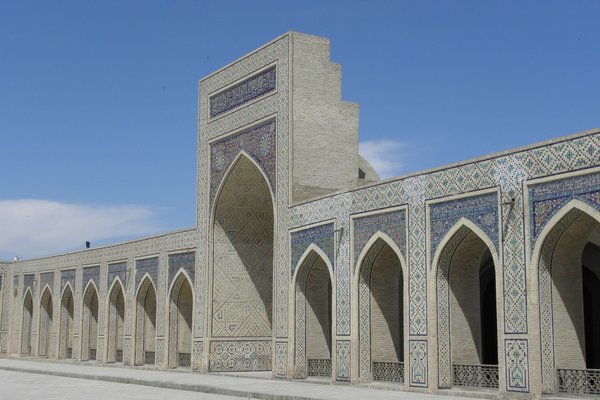Uzbekistan
Bukhara
The Historic Centre of Bukhara is the most complete and unspoiled example of a medieval Central Asian town, whose urban layout and buildings have greatly influenced town planning in the region.
Bukhara was also the largest center for Muslim theology in the Near East. Most major monuments that have survived are from the 16th century onwards, built during the Sheibanid dynasty when economic and cultural development was stimulated.
Community Perspective: A lively city that is worth multiple days. Solivagant has described how the city transformed between his two visits in 1983 and 2004. Els visited the 16th century hammam and Clyde has pointed out the best panoramic viewpoints.
Site Info
Official Information
- Full Name
- Historic Centre of Bukhara (ID: 602)
- Country
- Uzbekistan
- Status
-
Inscribed 1993
Site history
History of Bukhara
- 1993: Conditional inscription
- The inscription would only take effect if and when the tentative list of Uzbekistan is presented (it was only present at USSR Tentative List). They did so in 1994.
- 1993: Inscribed
- Inscribed
- 1991: Referred
- Bureau - needs new and more thorough evaluation
- Type
- Cultural
- Criteria
- ii
- iv
- vi
Links
- UNESCO
- whc.unesco.org
- Official
-
- uzbekistan.travel — uzbekistan.travel Bukhara
- Related
-
- tashkent.org — Link
All Links
UNESCO.org
- whc.unesco.org — whc.unesco.org/
Official Website
- uzbekistan.travel — uzbekistan.travel Bukhara
Related Resources
- tashkent.org — Link
News Article
- March 26, 2024 timesca.com — Demolitions in Bukhara Continue Despite UNESCO Demands for a Halt
Community Information
- Community Category
- Urban landscape: Asian
Travel Information
Samarkand Hotspot
Recent Connections
-
Samarkand Hotspot
Reachable in 2 hours by fast train -
Ella Maillart
As part of her book Turkestan Solo (193… -
Creative Cities
Crafts and Folk ArtSee www.unesco.org
Connections of Bukhara
- Individual People
-
-
Ibn Battuta
-
Ella Maillart
As part of her book Turkestan Solo (1932) -
William Moorcroft
The ostensible objective of Moorcroft's expedition to Turkestan was to improve the breeding stock of horses owned by the British by acquiring animals in both Tibet and Turkestan where, he had heard that Bukhara "had the greatest horse market in the World" (Marco Polo had described the merits of Turkoman hoses 500 years earlier). The journey was also a part of the wider "Great Game" to control Central Asia. Moorcroft first conceived the idea of reaching Bukhara for this purpose as early as 1816 and finally succeeded in April 1825... but found no special horses and a Russian mission under A Negri had reached Bukhara in 1820 to establish trade relations.
-
- History
-
-
Abbasid Caliphate
Tomb of the Samanids (early 10th century) -
Khorezm empire
Became part of the empire in the 11/12th century -
Silk Roads
Classic Land Route; cultural, trading and religious centre; "situated on the Silk Roads; profound influence on the evolution and planning of towns in a wide region of Central Asia" (AB ev)See en.unesco.org
-
Places of Execution
The Minaret of the Kalon mosque. "For here, on market days, particularly outrageous criminals were led up the 105 steps of this 'Tower of Death', whereupon their crimes would be enumerated to the transfixed crowd, the omniscient justice of the emir praised to the heavens and the accursed criminal tied in a sack and thrown off the top to hurtle to certain oblivion below. The gruesome spectacle was current well into the second half of the 19th century" -
Mongol Invasions
Siege of Bukhara: "The Mongol army killed everybody in the citadel and enslaved most of the city's population. The Mongols appropriated the work of skilled craftsmen and artisans, conscripting other inhabitants into their armies. Although Bukhara was then destroyed by fire, the destruction was relatively mild compared to elsewhere" (wiki)See en.wikipedia.org
-
Located in a Former Capital
Samanid 850- 999, Khanate of Bukhara c1530- 1922
-
- Architecture
-
-
Urban fabric
-
Timurid Architecture
Bukhara's Ulugh Beg Madrasah is built in Timurid style by Ulugh Beg, Timur's grandson -
Glazed tiles
-
Brick architecture
-
Muqarnas
Several including the Kalyan MinaretSee caravanistan.com
-
- World Heritage Process
-
-
Minor modifications after inscription
2016: to include Samanids and Chasmai Ayub mausoleums (in Bukhara city) and remains of the ancient walls and town gate (Talipoch gate) -
Already inscribed still on T List
Chashma-Ayub Mausoleum was added to the Bukhara WHS as minor boundary modification in 2016
-
- Religion and Belief
-
-
Jewish religion and culture
Jewish quarter -
Notable mosques
Kalyan Mosque (1514), Magoki-Attori Mosque (rebuilt in 20th century) -
Phoenix
Bukhara's Nadir Divan-Begi Madrasah has Phoenix decorative
-
- Constructions
-
-
Prison
The Zindan -
Caravanserai
Kuleta Caravanserai -
Horse Stables
Khanate Stables inside the Ark Fortress -
Bazaars and Market Halls
Tak-i Zargaron, a multiple dome-covered bazaar
-
- WHS on Other Lists
-
-
World Monuments Watch (past)
2020: Traditional Houses in the Old Jewish Mahalla of Bukhara -
U.S. Ambassadors Fund
Preservation of Artifacts from the Bukharan Oasis (2011), Preservation of the 18th-Century Friday Palace Mosque in Bukhara (2009) -
Creative Cities
Crafts and Folk ArtSee www.unesco.org
-
World Monuments Watch (past)
Madrasa Rashid, Bukhara (2008); Abdulazizkhan, Bukhara (2000) -
Aga Khan Award for Architecture
Restoration of Bukhara Old City (Bukhara, Uzbekistan)(1995)
-
- Timeline
-
-
Built in the 16th century
The most celebrated buildings date from the Shaybanid period (1500-1598)
-
- WHS Hotspots
-
-
Samarkand Hotspot
Reachable in 2 hours by fast train
-
News
- timesca.com 03/26/2024
- Demolitions in Bukhara Continue De…
Recent Visitors
Visitors of Bukhara
- Adrian Turtschi
- Afshin Iranpour
- Alberto Rodriguez Gutierrez
- Alejandro Lau
- Alexander Barabanov
- Alexander Lehmann
- Alexander Parsons
- Alikander99
- Ali Zingstra
- Aljaz
- A. Mehmet Haksever
- Ammon Watkins
- AmyAbroad
- Ana
- Argo
- arnaugir
- Artur Anuszewski
- Ask Gudmundsen
- Aspasia
- Atila Ege
- bergecn
- Bill Maurmann
- Bin
- Bram de Bruin
- Bundi Cao
- Carlos Sotelo
- chenboada
- Cheryl
- chiuliqi
- Christian Wagner
- christof
- Cirene Moraes
- Clyde
- Csaba Nováczky
- CugelVance
- CynthiaSam
- czesioszpachelka
- Danieljbromberg
- David Marton
- Deffra
- Dimitar Krastev
- DjhMck
- DL
- Dr. Caligari
- edstar500
- eljx1988
- Els Slots
- Emili Xaus
- Eric Lurio
- Erik Jelinek
- Eva Kisgyorgy
- Evgenii
- Fan Yibo
- Feldhase
- Fernweh
- Fmaiolo@yahoo.com
- Frederik Dawson
- George Gdanski
- Gernot
- Gilles
- giloudepuertorico
- giulio25
- Grzegorz Andruszkiewicz
- Hammeel
- HaraldOest
- Harald T.
- Harry Mitsidis
- H Beswick
- henryjiao18
- hotpickle
- Iain Jackson
- Ingrid
- irosey
- Ivan Rucek
- Janos
- Jarek Pokrzywnicki
- Javier
- Jean Lecaillon
- Jeffrey Chai
- JobStopar
- Jonas Kremer
- Jon Opol
- JoshHad
- Juha Sjoeblom
- jxrocky
- KarenBMoore
- Ken DJ
- Kevin McFarland
- Kevin Padley-Knight
- kiank37
- Krijn
- krtek
- La Concy
- Lado Joel
- Laetitia Yin
- Loic Pedras
- Lucio
- Ludvan
- Luis Filipe Gaspar
- Luke LOU
- Maciej Gil
- Maciej Gowin
- Malgorzata Kopczynska
- marcel staron
- Marcobrey
- Martin
- Martina Rúčková
- MatusBeber
- Michael Ayers
- Michael Novins
- Mihai Dascalu
- Mikko
- Milan Jirasek
- Miloš Tašković
- MMM
- Monica Tasciotti
- MoPython
- nan
- Niall Sclater
- Nihal Ege
- Patrik_globe
- Paul Schofield
- Philipp Leu
- Pieter Dijkshoorn
- Pink Bunny
- Piotr Wasil
- pressdm
- Rahelka
- ReallyDeepThoughts
- Reisedachs
- Reza
- Rick Ohm
- rivr
- Roger Ourset
- Roman Bruehwiler
- Sclowitz
- Sergio Arjona
- Simonf
- Solivagant
- Stan
- Stanislaw Warwas
- StaziG
- Szucs Tamas
- Tamara Ratz
- Tarquinio_Superbo
- Tatiana Nikulnikova
- Thomas Buechler
- Timothy C Easton
- TimPick
- Toxicologist
- Truls Brekke
- usagi1974
- Velvetlapis
- Vernon Prieto
- voyager
- Westwards
- Wo_ko
- Yevhen Ivanovych
- Yongcheng Liu
- zfish
- Zizmondka
- Zoë Sheng
- Zos M
Community Reviews
Show full reviews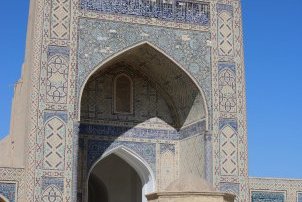
Bukhara is the middle child of uzbekistan's whs cities. Less monumental and lively than Samarkand, but more so than khiva. Less cohesive than khiva, but more so than Samarkand.
It is by far also the most diverse of them too. While khiva and Samarkand almost exclusively shine through a particular period (19th century and 15th century respectively) Bukhara has a bit of everything. It has brilliant pre-timurid architecture (samanid Mausoleum), timurid masterpieces (Ulugh begh madrasa) and later additions up to the 20th century (arq).
However out of the three cities I'm actually tempted to rank it last and that probably has to do with how touristic it felt. I think the high speed train has multiplied the number of people that go to the city in recent years. It was overcrowded and honestly overpriced.
The kunya arq was also a bit of a disappointment especially in retrospective when compared to the palaces in khiva.
The main pool has lost much of its charm, now infested with comically kitsch decor.
The madrasas are beautiful but surprisingly repetitive
On the bright side the kalyon mosque (phto) is perhaps the most impressive mosque in uzbekistan and the minarete is amazing.
Overall Bukhara left me mildly disappointed though with its splendid array it definetely deserves a place in the list.
Keep reading 0 comments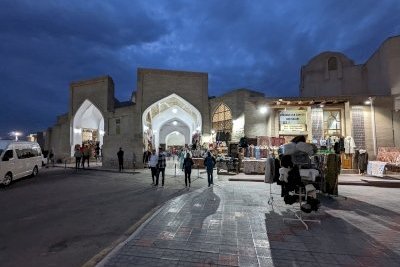
In the trifecta of great Uzbek Islamic silk road cities (Xiva, Bukhara, Samarkand), I think there are arguments for either city being the greatest. Samarkand is the biggest city and has the largest sites, but the historic sites are dispersed across a modern city. Xiva has a real old town, enclosed by historic walls, but doesn't have the one stellar site to shine. Bukhara's appeal is that it still has a charming old town feeling (but way less than Xiva) and undoubtedly plenty of stellar sites, most notably the square around Kalon minaret.
In the fall of 2022, I spent two nights in Bukhara and visited the old town on foot. The furthest west I got was the Talipach Gate. There were so many madrassahs, mosques, and mausoleums that it's hard to name one. Just take your time and wander the city open minded.
Getting There
When travelling in Uzbekistan, you can either visit Bukhara from the East (Xiva) or the West (Samarkand, Tashkent). Last option is to come from Turkmenistan (South), but as I understand it, border crossings are scarce and tourist entry and travel are highly restricted in Turkmenistan.
In Uzbekistan, there are trains and busses running between Xiva, Urgench, Bukhara, Samarkand and Tashkent. However, the distances are great and the normal trains slow. Between Bukhara, Samarkand and Tashkent there also bullet trains, but... these fill up quickly. And at least in Bukhara, the bullet train station is far away from the town centre, …
Keep reading 0 comments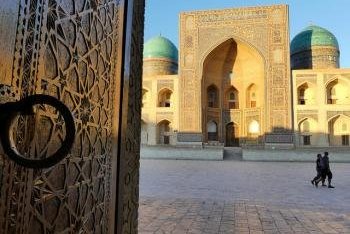
I visited this WHS in June 2017 and spent 4 nights here. Like Samarkand, to me it is one of the top WHS on the list and certainly Uzbekistan most lively WHS. Unlike Samarkand, the medieval atmosphere is still alive and if you wake up just after sunrise and wander through the residential areas or market area you will notice that not much has changed. I really enjoyed watching the local children meet up just after sunset in front of the active Miri Arab Madrasah (photo) to play football beneath the Kalyan minaret.
The restoration works were much better than Samarkand and much of the historic centre has been preserved (not only single sites or monuments). In Samarkand, I wasn't able to find one single mention of UNESCO anywhere. Here every inscribed building (as well as those on the tentative list!) have a plaque and then there is a bronze plaque with the inscription certificate engraved just in front of the Hoja Nasruddin statue.
During one of the days I visited, on the last day of Ramadan, many Muslims came from all over the province for the community Iftar, the evening meal when Muslims end their daily Ramadan fast at sunset. The Kalyan mosque was full of people eating and celebrating during that evening but apart from that time, in Summer locals seem only to go out early in the morning to buy local produce at the market and after sunset.
Another highlight during my visit were the local hammams …
Keep reading 0 comments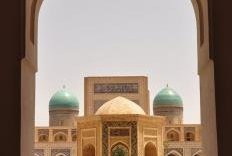
Located in the middle of Kyzyl-Kum Desert, Bukhara, a historic city on the great ancient Silk Road, is liked a mirage from the Arabian nights fairy tales with many outstanding monuments that easily take your breath away. Seeing monuments of Bukhara is quite straightforward as all important sights are located in single tourist routes from the amazing brick mausoleum of Ismail Samani to great Kalon Minaret complex with inspired Kalon Mosque and end at the photogenic four towers of Char Minar.
Other monuments are also worth mentioned, the wooden carving columns of Bolo-Hauz Mosque near the Ark Fortress are just gorgeous, the newly restored façade of Abdul Aziz Khan Medressa is so unbelievably colorful that you may think that you are in India’s Rajasthan and truly one of my favorite, and the relaxing area of recently renovated Lyabi-Hauz with the nearby beautiful mosaic of Nadir Divanbegi Medressa. The well-preserved bazaar buildings are exceptional with the sophisticated roof. However, similar to other places in Uzbekistan, almost all Bukhara’s religious monuments had been turned to souvenir complexes and restaurants which sometime really destroyed the atmosphere of the place.
As mentioned, the Lyabi-Hauz area had been renovated as well as many areas in the old city, those areas are very clean and so well organized liked the museum city of Khiva, which totally contrast to un-renovated of Bukhara. In my opinion, Bukhara has potential to become second Khiva, which I don’t think a good example as the city will …
Keep reading 0 comments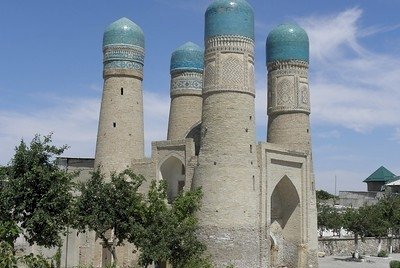
Undoubtedly my most powerful memory of Bukhara is sitting at the square, gazing at the Kalan minaret. It is so perfectly shaped. The adjoining mosque is another masterpiece. The same can be said of the little Ismail Samani mausoleum, dating from the 9th-10th century, and the four turrets of the Chor Minar.
Bukhara is a great destination: compared to the other Uzbek sites it is more lively than Samarkand and less museum-like than Khiva. It has a lot on offer from different periods and merits a visit of at least 3 days. In the evenings you can relax, eat and drink on one of the terraces around the Lab-i Hauz pond. This area especially has become touristy, as have the bazaars. Although Uzbekistan cannot be considered a major tourist destination, enough of them come here to provide a living for the many restaurants, hotels and souvenir sellers in town.
Part of the WHS is also the 16th-century women's hammam. It was my first visit to a hammam ever and a memorable experience. Imagine sweating away in a 500-year-old monument that has been used by many many women in this period. At first, I was still in my "visiting a monument"-mode, just admiring the heated cells covered all over with large dark gray stones. The image then was completed by the arrival of several very fat naked Uzbek women, scrubbing each other or lying on the cold floors pouring buckets of water on themselves. It is rare that one …
Keep reading 0 comments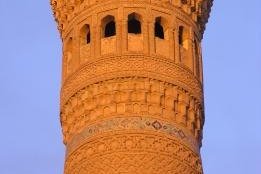
We have visited Bukhara twice, once in Soviet days (1983) and again in Oct 2004 – and what a difference! Free enterprise has turned a dour dusty “museum city” into a lively “Persian (or rather “Uzbek”!) Market”.
In Soviet times all tourists stayed at the Intourist run Bukhara Hotel in the new town. We went to visit it for “auld lang syne” and found it now very down market (although even in Soviet days it had become infamous as the seat of a cholera epidemic which attacked western tourists!) and seemingly only used by locals. Its restaurant, where we had waited for so many hours to be served unappetising food by surly waitresses, was closed and empty of tables. The deserted foyer still exuded its tacky Soviet persona with its cheap wood veneers and decorations. The Intourist Souvenir stand which sold little, apart from those Russian dolls which fit inside each other, had a film of dust on it and its glass fronted shelves were even emptier than they used to be. A real “time warp”!
Instead a number of new private hotels have been built or converted from old city buildings but, as yet no “chain hotels”. Restaurants had appeared, catering for a range of levels and tastes (even including an Italian!). The old domed covered markets were full of shops selling carpets, carved woodwork, embroidery, metal-ware, pottery, Astrakhan hats etc etc. One wonders where the craftsmen had been hiding during those long Soviet years –the quality of the …
Keep reading 0 comments
